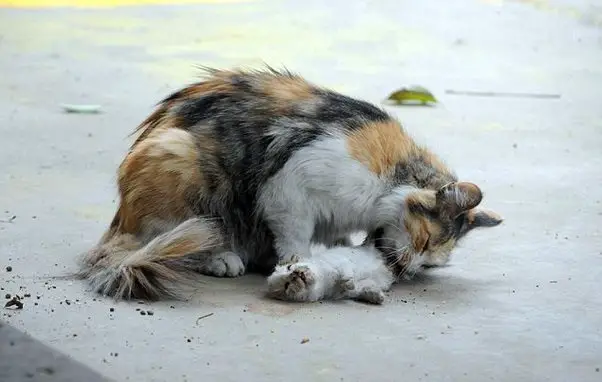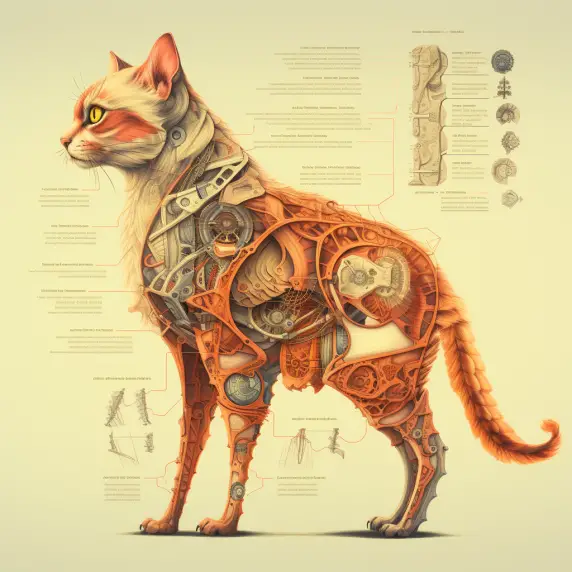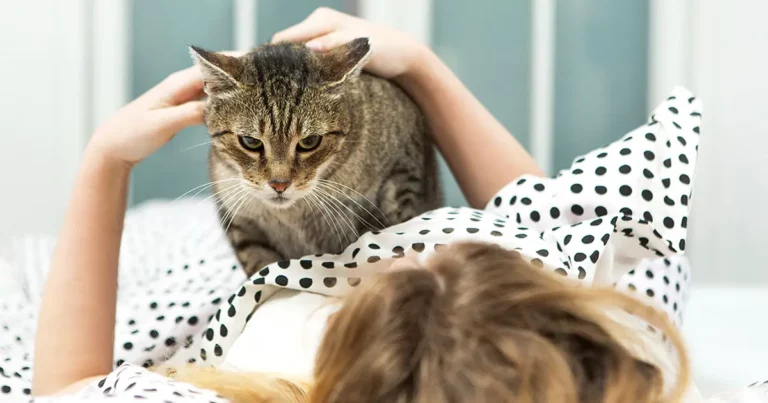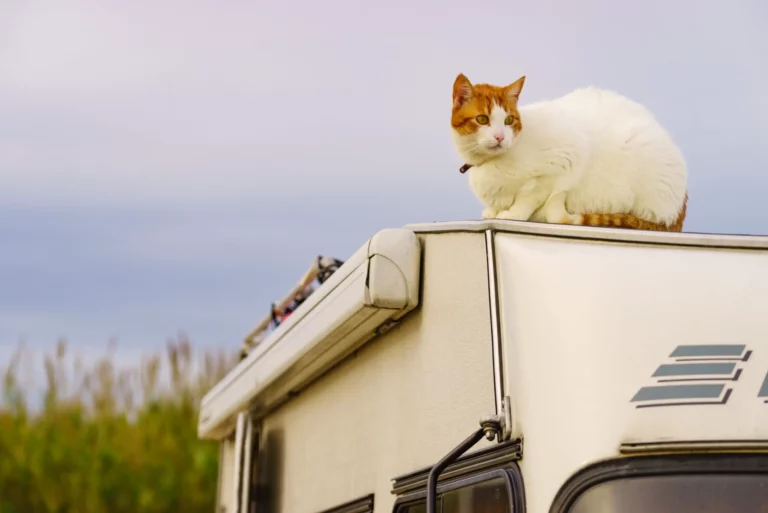How to Transition Your Cat to a Covered Litter Box
As a cat parent, you’ve probably pondered over the question, “how to transition a cat to a covered litter box?” It’s a query that often pops up when looking for ways to manage pet odors better or give your feline friend some privacy.
This transition, however, isn’t always smooth and requires some understanding of your cat’s needs and a generous dash of patience. Let’s delve into the various strategies that can help you successfully introduce your cat to a covered litter box, ensuring a stress-free experience for both of you.
Before we dive into the specifics, let’s look at the main points this guide will cover:
- Cats have preferences: Understanding your cat’s needs and preferences can play a crucial role in the transition process.
- Covered litter boxes offer benefits: They help control odors and offer cats a sense of privacy.
- Choosing the right litter box matters: Size, style, and ease of access are key considerations when choosing a covered litter box.
- Patience and positive reinforcement are key: Transitioning your cat to a new litter box may take time. Celebrating small victories can encourage your cat to accept the change.
- Observation is crucial: Monitor your cat’s behavior to gauge their comfort levels with the new litter box and be ready to make adjustments if needed.
The aim is to ensure a seamless transition while prioritizing your cat’s comfort and happiness.
Let’s get started!
Open vs. Covered Litter Boxes: Cat Preferences and Why They Matter
When it comes to litter boxes, cats typically have strong preferences. These preferences often stem from their natural instincts. As descendants of wild cats, domestic cats have an instinctual need to eliminate waste in a way that does not attract predators. They prefer a clean, quiet, and safe space to do their business.
Traditionally, open litter boxes have been a go-to option for many cat parents. They offer cats a wide and unrestricted view of their surroundings, reducing any feelings of vulnerability while they’re in a compromised position. However, some cats might appreciate the privacy and seclusion that a covered litter box can offer.
But it’s essential to remember that a one-size-fits-all approach doesn’t work here. Some cats might prefer the openness and easy access of an open box, while others might appreciate the security and privacy of a covered one. Understanding your cat’s unique preferences is the first step toward a successful transition.
To gauge your cat’s preferences, consider their behavior around their current litter box. Are they comfortable doing their business even with people around, or do they often wait for solitude? Answering questions like these can provide you with valuable insights into whether your cat would prefer an open or covered litter box.
Remember, prioritizing your cat’s comfort and security can make a significant difference in the transition process, making it smoother for both you and your furry friend.
Benefits of a Covered Litter Box
The debate of open vs. covered litter boxes often comes down to the unique needs and preferences of your cat. However, there’s no denying the potential benefits that come with choosing a covered litter box. Let’s explore a few:
- Odor Control: Covered litter boxes are highly effective in containing unpleasant smells. The cover traps odors inside, keeping your living space fresher.
- Privacy: Cats, like humans, appreciate a bit of privacy at times. Covered litter boxes can provide a secluded space for your cat to do their business without feeling exposed or vulnerable.
- Mess Containment: Cats are notorious for kicking litter around during their toilet routine. A covered box can contain the mess inside, keeping your floors cleaner.
- Prevents Overshooting: Some cats stand while urinating, and a covered litter box can prevent any overshooting incidents, keeping the surrounding area clean.
- Appealing Aesthetics: Covered litter boxes often blend better with home decor, offering an aesthetically pleasing solution to a necessary pet accessory.
Understanding these benefits can help you better communicate the change to your cat and patiently work through any initial hesitation they might show towards the new litter box setup.
No products found.
Selecting the Right Covered Litter Box
Once you’ve decided to transition your cat to a covered litter box, the next step involves choosing the right one. But with a myriad of options available on the market, this decision might feel daunting. Here are a few factors to consider to ensure you pick the most suitable covered litter box for your feline companion:
- Size Matters: Cats prefer spacious litter boxes where they can comfortably turn around and sift through the litter. Ensure the covered litter box you choose is at least 1.5 times the length of your cat.
- Ease of Access: The litter box’s entrance should be easy for your cat to use. This might mean opting for a box with a lower entrance for older cats or cats with mobility issues.
- Ventilation: A covered litter box must have good ventilation to ensure that the smells don’t become overwhelming for your cat. Look for one with vents or filters.
- Cleaning Ease: A litter box that’s easy to clean will make maintenance simpler for you and will ensure a clean environment for your cat. Boxes with removable covers or doors can be more convenient.
- Quiet Space: Cats prefer quiet, peaceful areas for their bathroom needs. A covered litter box with a door can provide a more secluded and calm space for your cat.
- Aesthetic Appeal: If you care about the litter box fitting in with your home’s decor, consider the design, color, and overall look of the covered litter box.
Making an informed choice considering these factors can ensure your cat adapts more readily to the covered litter box, making the transition smooth and successful.
How to Train a Cat to Use a Litter Box with a Door
Training your cat to use a covered litter box with a door can be a bit challenging as it’s another layer of novelty for your cat to get used to. However, with a little patience and the right strategies, it’s entirely possible. Here’s how you can guide your cat through this transition:
- Gradual Introduction: Instead of immediately replacing the old litter box with the new covered one, place them side by side. This allows your cat to become accustomed to the new box without feeling forced to use it.
- Door Open Initially: Leave the door of the new litter box open initially. This gives your cat an opportunity to explore the box without feeling trapped.
- Use Familiar Litter: Fill the new box with the same type of litter your cat is used to. This familiarity can be comforting and inviting.
- Positive Reinforcement: If your cat uses the new litter box, even just to explore, reward them with their favorite treat. This positive association can encourage repeat visits.
- Gradually Introduce the Door: Once your cat starts using the new box regularly, slowly start introducing the door. You can begin by propping it open before eventually allowing it to swing freely.
- Patience is Key: Remember, this is a significant change for your cat, so patience is crucial. If your cat is resistant to using the new box, don’t force them. Allow them to adjust at their own pace.
With these steps, your feline friend should eventually be comfortable using their new covered litter box with a door. It’s all about understanding their needs and making the process as stress-free as possible.
Will My Cat Use an Enclosed Litter Box?
Many cat owners often wonder, “Will my cat use an enclosed litter box?” The short answer is: Yes, they can. However, the transition might not be seamless for all cats. It’s crucial to remember that each cat is unique, and their acceptance of an enclosed litter box largely depends on their personality, preferences, and past experiences.
Cats who appreciate privacy might readily accept an enclosed litter box as it offers a secluded, personal space for them. On the other hand, cats who are more cautious or claustrophobic might initially resist the change due to the confinement they might feel in an enclosed box.
The key to a successful transition lies in understanding your cat’s needs and introducing the new litter box gradually and sensitively. Make sure the box is spacious enough and is kept clean and odor-free. Try to locate the box in a quiet and easily accessible area of your home. And most importantly, exhibit patience throughout the process.
Keep in mind that the ultimate goal is your cat’s comfort and well-being. If despite your best efforts, your cat still shows signs of distress or refuses to use the enclosed box, it might be better to reconsider the change. After all, a comfortable cat is a happy cat!
Recognizing Signs Your Litter Box Is Too Small
A common issue that may deter cats from using their litter box—open or covered—is the box’s size. An appropriately sized litter box allows your cat to comfortably move and turn around. If your cat’s litter box is too small, it might lead to distress and avoidance. Here are some signs that your litter box might be too small:
- Overflows: If you frequently find litter or waste outside the box, it might be an indication that the box is too cramped for your cat’s liking.
- Hesitation to Use the Box: If your cat appears uneasy or hesitant about entering their litter box, it could be because they feel too confined inside.
- Incomplete Burial of Waste: Cats naturally bury their waste in the litter. If your cat is unable to do this properly, it might be due to a lack of space.
- Accidents Outside the Box: A cat that consistently does its business outside the litter box might be telling you that their box is too small or uncomfortable.
- Uncomfortable Body Language: Watch your cat while they’re using the box. If they appear uncomfortable or struggle to turn around or position themselves, it’s a clear sign the box is too small.
Remember, comfort is critical when it comes to litter boxes. If you notice any of these signs, consider upgrading to a larger size. When transitioning to a covered litter box, make sure it’s spacious enough for your cat to comfortably use, which can significantly ease the transition process.
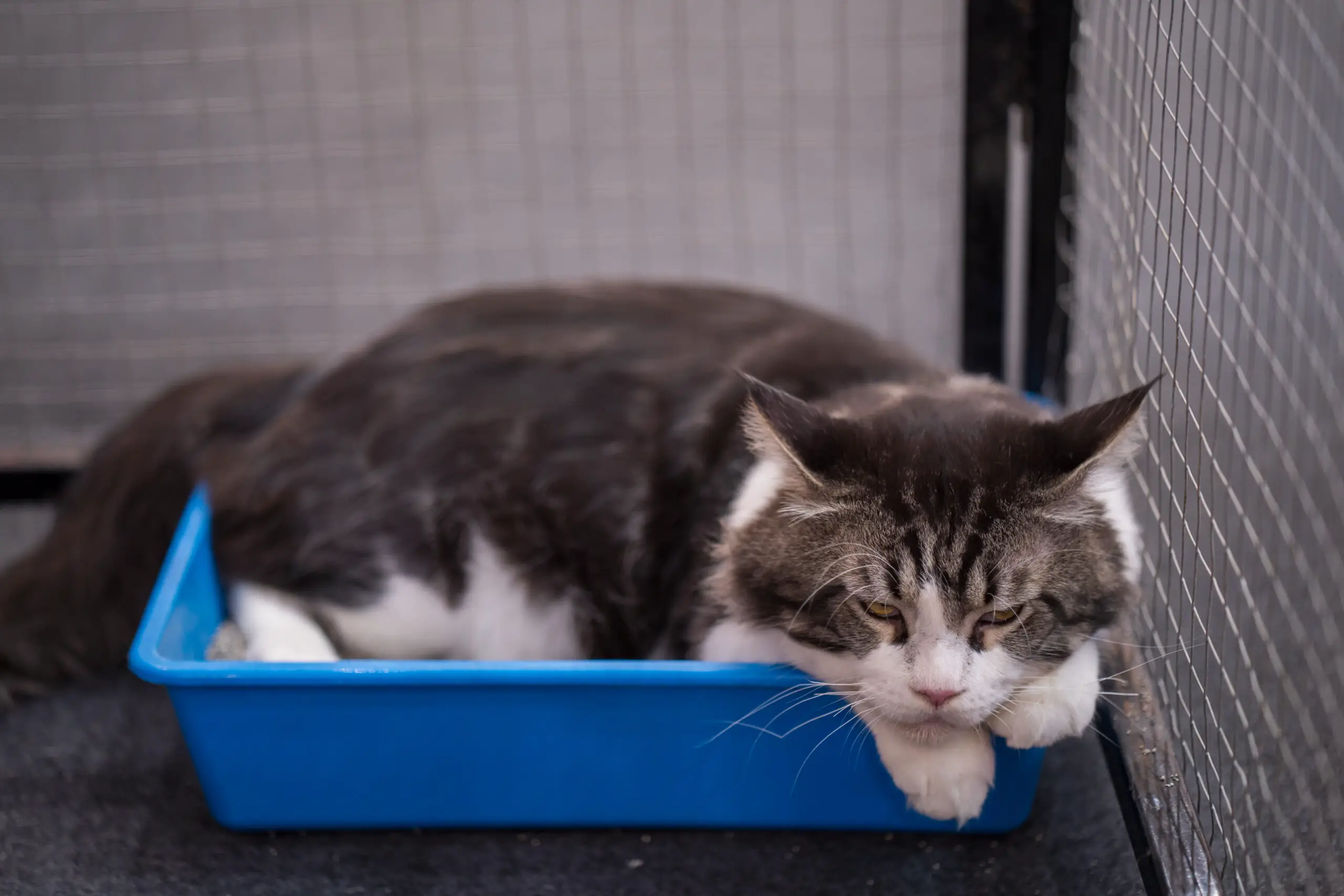
Overcoming a Cat’s Dislike for Enclosed Litter Boxes
Sometimes, despite your best efforts, your cat might show a strong dislike for the new enclosed litter box. Don’t be disheartened—cats are creatures of habit and any change can be difficult for them. Here are a few steps you can take to overcome this challenge:
- Be Patient: Changing a cat’s habits can take time. Don’t rush the process; let your cat adjust at their own pace.
- Keep the Old Box: Temporarily keeping the old box can help your cat adjust. As they become more comfortable with the enclosed box, you can gradually phase out the old one.
- Ensure Cleanliness: Enclosed litter boxes can accumulate odor more than open ones. Regular cleaning is essential to keep the environment pleasant for your cat.
- Consider Location: The box should be placed in a quiet, low-traffic area of your home. This can make the enclosed space feel less threatening.
- Try Different Boxes: If your cat continues to resist, consider trying different types of enclosed boxes. They might prefer a box with a top entrance, a larger size, or a different door type.
Remember, while many cats can successfully transition to using an enclosed litter box, it’s not for everyone. If your cat seems stressed or unhappy despite your efforts, it’s best to prioritize their comfort and stick with what they prefer.
Can Kittens Use Hooded Litter Trays?
When it comes to kittens, the question arises, “Can kittens use hooded litter trays?” The answer is, Yes, they can, but with some caveats.
Kittens, much like their adult counterparts, can use hooded litter trays. However, the process might be a bit more complicated due to their smaller size and less developed motor skills. Here are some tips to ensure a smooth transition:
- Choose the Right Size: The litter box should be small enough that your kitten can easily get in and out, but large enough for them to move around comfortably.
- Keep the Door Open: At first, you might want to keep the door open or even remove it completely. This will make the box less intimidating for your little one.
- Show Them the Way: Kittens may need a bit of guidance. Show them the entrance and gently place them inside a few times until they get the hang of it.
- Monitor Their Usage: Keep an eye on your kitten’s usage of the box. If they seem uncomfortable or avoid using it, they may not be ready for a covered tray just yet.
While kittens can be trained to use hooded litter trays, remember that their comfort and ease of use should be your primary concern. They may need a bit more time and patience to get used to the new setup, so take it slow and ensure they’re comfortable every step of the way.
Step-by-Step Guide to Introduce a Covered Litter Box
Transitioning your cat to a covered litter box can be a process that requires patience and understanding. Here’s a step-by-step guide to making the transition smoother and more comfortable for your feline friend:
- Select the Right Box: Choose an enclosed litter box that’s large enough for your cat to turn around in and easy for them to enter and exit.
- Place the New Box Next to the Old One: This allows your cat to get used to the presence of the new box without feeling forced to use it.
- Use the Same Litter: Keep things familiar by using the same type of litter in the new box as in the old one.
- Remove the Lid Initially: Start by removing the cover so your cat can get used to the new box in stages. Once they are using the base regularly, you can reintroduce the lid.
- Offer Rewards: Positive reinforcement can go a long way. Reward your cat with treats and praise when they use the new box.
- Clean Regularly: Enclosed boxes can trap odors, so be sure to clean the box regularly to make it more appealing to your cat.
- Patience is Key: Remember, it’s a big change for your cat, and they might need some time to adjust. Don’t rush the process.
By following these steps and considering your cat’s needs and comfort at all times, the transition to a covered litter box can be a successful one.
Signs of Acceptance or Discomfort
A significant part of the transition process involves closely observing your cat’s behavior. This will provide valuable clues about their comfort levels and acceptance of the new covered litter box. Here are some signs to watch out for:
Signs of Acceptance:
- Regular Use: The most apparent sign of acceptance is regular use. If your cat is consistently using the new box without issues, they have likely accepted the change.
- Relaxed Body Language: A cat at ease will exhibit relaxed body language. They’ll enter and exit the litter box smoothly without signs of stress or unease.
- Continued Normal Behavior: If your cat continues their normal routine—eating, sleeping, and playing as usual—it’s a good indication they have accepted the change.
Signs of Discomfort:
- Avoidance: If your cat is avoiding the new box or going outside of it, they may not be comfortable with the covered design.
- Agitation: Signs of agitation like scratching outside the box, meowing, or appearing restless around the box could indicate discomfort.
- Changes in Bathroom Habits: If your cat is suddenly having accidents around the house, it may be because they don’t like the new box.
By understanding these signs, you can adjust your approach to make the transition more comfortable for your cat. Remember, each cat is unique, so it’s essential to respect their preferences and move at a pace they are comfortable with.
Expert Tips: Ensuring a Successful Transition
Transitioning your cat to a covered litter box can be a delicate process. To maximize your chances of success, consider these expert tips:
- Multiple Boxes: If you have more than one cat, provide multiple litter boxes. The general rule is one box per cat, plus one extra.
- Gradual Transition: Make changes gradually. Suddenly replacing the old box with a new one can cause stress. Instead, introduce the new box while keeping the old one available.
- Consistent Litter: Use the same type of litter in the new box that you use in the old one. Cats can be very particular about the texture and smell of their litter.
- Cleanliness: Maintain cleanliness. Enclosed boxes can hold odors, so clean the box regularly to ensure it remains appealing.
- Privacy, Not Isolation: Cats like privacy when they’re doing their business, but they don’t want to feel isolated. Place the box in a quiet, accessible location, not in a remote corner of the house.
- Respect Their Preference: If your cat absolutely refuses to use the new box despite your best efforts, it may be best to stick with what works for them. After all, their comfort is paramount.
Remember, patience and understanding are key in this transition. If you respect your cat’s needs and preferences, you’ll both navigate this change successfully.
Frequently Asked Questions
How do I get my cat to use a new covered litter box?
A gradual introduction is the key. Start by placing the new box next to the old one without the cover. Once your cat starts using the new box regularly, you can slowly introduce the lid. Also, using the same litter as in the old box can make the new one seem more familiar.
Are cats OK with covered litter boxes?
Some cats prefer covered litter boxes for the extra privacy they provide, while others may feel trapped or uncomfortable due to the limited space and odor concentration. It largely depends on individual preferences.
Why won’t my cat use the hooded litter box?
There could be a variety of reasons, such as the box being too small, the presence of the door, or simply the unfamiliarity of the new box. If the hooded litter box is large enough and clean, you might try removing the door or introducing the box gradually without the cover first.
Will my cat use an enclosed litter box?
Most cats will adapt to using an enclosed litter box, but it may take some time and patience. The key is to introduce the change gradually and ensure the box is of adequate size and kept clean.
How to train a cat to use a litter box with a door?
Begin by removing the door so your cat gets used to the new box first. Once they are comfortable with the box, reattach the door and monitor their reaction. If they seem hesitant, try propping the door open initially before letting it swing freely.
What type of litter box do cats prefer?
Cats’ preferences can vary, but most cats prefer large, clean boxes that give them plenty of space to move around. Whether the box is covered or uncovered depends on individual cat preferences. Some cats enjoy the privacy of a covered box, while others prefer the open space of an uncovered one.
Can kittens use hooded litter trays?
Yes, kittens can use hooded litter trays, but the box must be easily accessible to them. The hood can be added once the kitten has grown a bit and is comfortable using the base tray. Ensure that the litter depth is suitable for a kitten—about one inch deep.
Final Thoughts: Reinforcing Positive Litter Box Habits
The transition from an open to a covered litter box isn’t always straightforward, but with patience, respect for your cat’s preferences, and by monitoring their behavior, it can be achieved successfully.
Keep in mind that the overall goal is your cat’s comfort and well-being and that their acceptance of a new type of litter box may take some time. Remember, reinforcing positive habits and associations will help smooth the transition and ensure a stress-free experience for your feline friend.
Your dedication to understanding your cat’s needs and maintaining a clean, welcoming environment for their necessities will pay off in fostering a happy and comfortable home for both of you.


![Why Does My Cat Keep Pooping Outside the Litter Box? [5 Things You Can Do]](https://www.warmlypet.com/wp-content/uploads/2023/01/senior_cat_not_using_litter_box-1024x548-1-768x411.webp)
